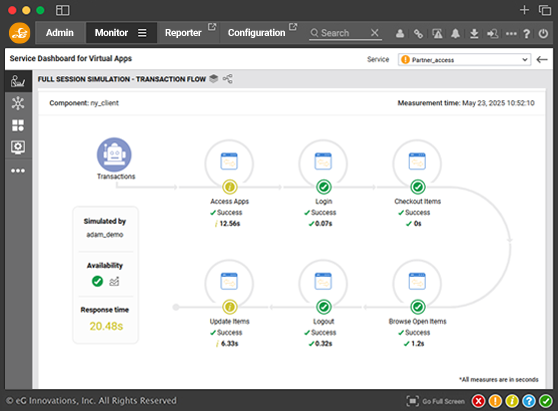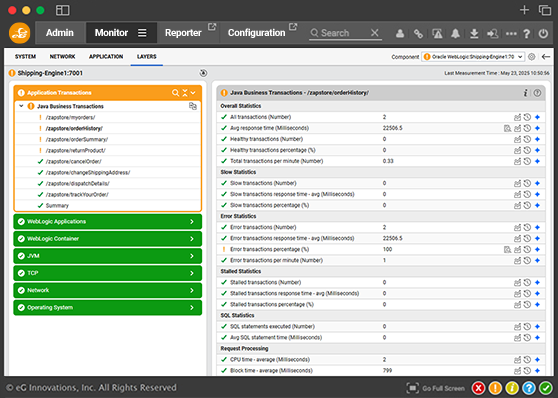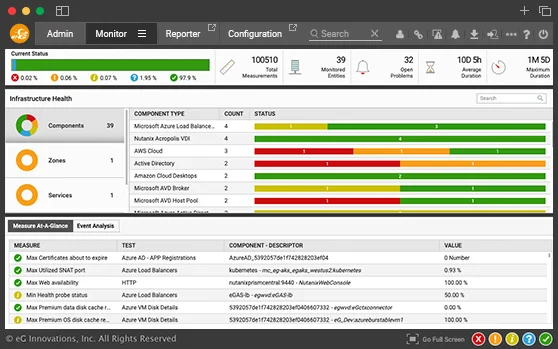End User Experience Monitoring Tools
The digital experience of users is the benchmark for IT performance today. Improve business outcomes by monitoring end user experience for any application, from any client.
Free TrialWhy Monitor the Digital Experience
Picture this: a customer lands on your eCommerce site, ready to buy. But the product page takes just a few seconds too long to load. They get frustrated, abandon their cart, and head to a competitor. Sound familiar?
Slow page loads, broken checkout flows, and performance hiccups can silently erode your revenue and damage your brand. That’s where eG Enterprise comes in.
With Real User Monitoring (RUM), you see exactly how real customers are interacting with your site—in real time. Get insights into page load times, failed transactions, geographic slowdowns, and device/browser-specific issues. RUM helps you detect performance gaps as they happen, so you can fix them fast and protect your bottom line.

But what about those problems that creep in overnight, or before a big campaign launch? That’s where Synthetic Monitoring shines. By simulating user journeys 24/7, you can proactively test key workflows—like product searches, add-to-cart actions, and checkout—before your customers ever encounter them.
Why settle for either-or when you can have both?
As enterprises are increasingly relying on websites and web applications to deliver business services, they are constantly faced with the struggle to deliver a fast and uninterrupted digital experience to end users. Even a slight delay in page load time translates into lost revenue, poor customer satisfaction and negative brand impact. For example:
- As explained in a blog by GigaSpaces, a one second increase in page load time for Amazon translates into a 1% drop in sales (about $1.6 billion in sales annually).
- Google found that a delay of 0.5 seconds in search page load time dropped traffic by 20%.
Measuring the user experience at all times is a key to achieving faster problem diagnosis and resolution and ensuring enhanced website experience for customers. A recent Gartner survey concluded that end-user experience monitoring is the most critical dimension of application performance management (APM).
It’s essential to have systems in place to enable end user experience management that provide real-time data analysis. Using tools like end-user monitoring software enables businesses to gain valuable insights into customer behavior, enhance application performance, and proactively address issues, ultimately driving improved customer satisfaction and business outcomes.
Challenges in Digital End User Experience Monitoring

As web applications evolve to deliver highly interactive, visually rich content, web user experience monitoring has become more complex than ever before. Today’s applications rely on distributed, multi-tiered architectures, dynamic front-end frameworks, and a growing web of third-party integrations—all of which can introduce unpredictable performance issues.
What is End-User Experience?
End-user experience refers to the perceived quality, performance, and satisfaction users derive from interacting with digital systems, such as websites, SaaS applications, and enterprise portals. It encompasses not just speed and availability, but also usability, reliability, and responsiveness across devices and locations.
While traditional end user experience monitoring tools focus on server-side metrics like CPU usage or memory, these metrics alone no longer reflect what users actually experience. Real performance issues often originate closer to the user—from browser-side rendering, content delivery networks (CDNs), or JavaScript execution. Without visibility into the client side, IT teams are left guessing when trying to troubleshoot user complaints.
Common Challenges in Monitoring
End-User Experience
- Lack of client-side visibility: Many tools, including UX monitoring tools, focus primarily on back-end infrastructure monitoring - overlooking delays caused by browser rendering, third-party scripts, or large web objects.
- Geographic variability: Performance can vary widely depending on the user’s location, local ISPs, or CDN edge node efficiency.
- Third-party dependencies: Embedded services like payment gateways, analytics tools, or ads can fail or slow down the page without the app owner's knowledge.
- Dynamic content and APIs: Modern apps rely on REST APIs and asynchronous requests that can degrade performance without triggering server alarms.
- Device and browser diversity: User experience can differ significantly across mobile vs. desktop, or Chrome vs. Safari, making troubleshooting inconsistent behavior difficult.
- Reactive alerting: Without synthetic testing or real user monitoring (RUM), issues are often discovered only after users are impacted.
To deliver consistently great digital experiences, organizations need a solution like eG Enterprise that provide deep visibility from the user’s browser all the way to the backend infrastructure—ensuring faster resolution, fewer surprises, and happier users.
Digital Experience Monitoring with
eG Enterprise
eG Enterprise is a total end user experience monitoring software that measures the business service impact from the user experience perspective. Having comprehensive end-user experience monitoring tools enable you to monitor how customers interact with your websites in real time and synthetically test performance 24x7. eG Enterprise provides built-in user experience metrics and actionable insights to proactively alert you to all client-side issues. Intuitive dashboards, reports and user experience metrics help you track customer satisfaction and easily address performance issues before there is a business impact. When you're committed to providing great user experiences, utilizing a user experience monitoring solution is essential to effectively track and measure your success.
eG Enterprise includes two approaches to measure digital user experience:
- Passively, using real user experience monitoring (RUM)
- Actively, using synthetic transaction monitoring
We have no more frustrations because now we know where the problem is, and the root cause of issues is detected in minutes. With the eG Enterprise performance monitoring suite we deliver a robust and reliable environment that guarantees maximum uptime and user satisfaction. ![]()
Optimize Digital Experience
with Real User and Synthetic
eG Enterprise empowers IT teams to deliver exceptional digital experiences by combining the strengths of Real User Monitoring and Synthetic Monitoring.
Real User Monitoring (RUM)
captures actual user interactions with applications in real time. It provides deep insights into how users experience your services—tracking metrics like page load times, transaction delays, error rates, and geographic performance variations. With this data, IT teams can quickly detect performance issues, identify trends, and prioritize fixes based on real-world impact. RUM helps answer questions like: Where are users struggling? Is performance worse in certain regions or browsers?
Synthetic Monitoring
on the other hand, uses simulated user transactions to test application availability and responsiveness 24/7—even when no real users are active. It proactively identifies issues before they affect users by running scripted checks on key workflows. Synthetic monitoring is ideal for testing new deployments, monitoring third-party dependencies, and ensuring SLA compliance.
Why Use Both?
Why Use Both? When RUM and synthetic monitoring are used together, eG Enterprise delivers complete, end-to-end digital experience assurance. RUM highlights how users are actually experiencing the application, while synthetic monitoring ensures predictable performance and availability through constant testing. Together, they provide full coverage—real-time visibility into user journeys and proactive detection of issues before users notice.
This powerful combination enables faster troubleshooting, improved uptime, and a smoother experience for every user, everywhere.
This dual approach equips IT teams with the complete set of KPIs and metrics needed to monitor and optimize user experience across all touchpoints, including:
Together, RUM and synthetic monitoring in eG Enterprise deliver the depth and breadth needed for true digital experience assurance.
Troubleshoot User Experience Issues
eG Enterprise, one of the most sought-after end-user experience monitoring tools, goes beyond surface-level insights to deliver intelligent, end-to-end diagnostics powered by patented root cause analysis and AIOps. IT teams can quickly identify and resolve user experience problems with advanced features such as:
eG Enterprise brings RUM and synthetic monitoring together for complete digital experience assurance. React instantly to what’s affecting your users now and prevent the next issue before it costs you a sale.
If customer experience is your competitive edge, eG Enterprise is the tool that helps you keep it sharp.
















